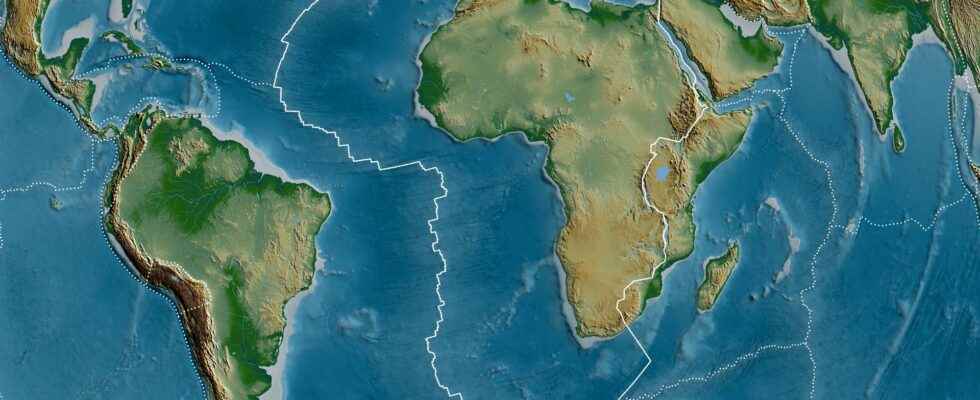We are not aware of it, but the tectonic plates move slowly under our feet, at the speed of a few centimeters per year, driven by major tectonic and convective processes.
You will also be interested
[EN VIDÉO] A billion years summarized in 40 seconds: plate tectonics Researchers have modeled the movements of tectonic plates over the past billion years.
The Earth’s crust is cut into 12 main tectonic plateswhich are, in order of size: the Pacific, Eurasia, Africa, Antarctic, India-Australia, North America, South America, Nazca, Philippine, Arabia, Coco and Caribbean. The tectonic plates can combine continental crust and some oceanic crust. These are tectonic entities. Their limits are characterized by a movement differential that generates strong seismic and magmatic activity. The ridges are therefore naturally tectonic plate boundariesas well as the areas of subduction.
A relative movement
The plates are defined according to their relative movements with respect to each other. To the first order, each plate thus moves as a tectonic entity, even if some can be subdivided into several plates if one takes into account relative movements of second order. This is the case of the India-Australia plate which can be divided into two sub-plates: the Indian plate and the Australian plate, due to small differential movements. The Somalia plate can thus also be differentiated from the Africa plate.
As the Earth is a sphere, any movement at a point necessarily involves a global movement. Nothing is fixed on the surface of the globe. Each tectonic plate thus moves with a certain speed and in a certain direction, under the engine of plate tectonics. The movement of the continents is therefore intimately linked to major tectonic processes such as the subduction zones which lead to a movement of convergence, and the process ofaccretion oceanic also called oceanic expansion, which generates, as for him, a movement of divergence. Everything is governed by the mechanism of mantle convection which sits deep beneath the earth’s crust.
Speeds of 1 to 10 cm/year
As all the plates are in motion on the surface of the globe, the velocities of the different tectonic plates must be given relative to a reference point. Scientists can thus consider a plate as fixed and give the relative motion of other plates with respect to it. One can also consider the motion of the plates with respect to some hot spots, which are relatively fixed magmatic structures over geological time. To harmonize scientific communication, however, there is a reference system called “ no-net-rotation in which the movement average is zero. It’s a bit like considering the motion of the plates relative to the center of the Earth, or relative to the hot spots fixed. In this frame of reference, the continental plates move globally at speeds ranging from 1 to 10 cm/year. The “fastest” plates are the Pacific plates (10 cm/year towards the northwest), the Philippine plate (8 cm/year towards the west), the India-Australia and Nazca plates (7 cm/year towards north and east, respectively) and the Coco Plate (5 cm/yr northeast). The other plates have a speed of less than 3 cm/year.
Animation showing the tectonic evolution of the Earth’s plates since the time of Pangea, 240 million years ago. © C. Scotese, Paleomap Project, YouTube
Evidence of plate movement
If these speeds seem low, on the scale of geological time they lead to the bursting and regrouping of supercontinents. The speeds of the plates are therefore variable over time and can experience accelerations as well as decelerations. Similarly, the direction of movement of a plate can change suddenly under the effect of global reorganizations of the plates or the initiation of a subduction, for example. These changes in orientation are visible for example in the layout of the volcanic islands of the hotspots. The best witnesses to the movement of the plates and their past velocities are however the magnetic anomaliesrecorded as the formation of the floor oceanic. The volcanic rocks of the oceanic crust, recording the direction of the magnetic field environment during their crystallization, give precious indications on the speeds of oceanic expansion of the past.
However, more complexity must be introduced, because when looking at a map representing the movement of tectonic plates, we realize that the speed and direction of the movement are not uniform at each point of a plate. Each tectonic entity thus seems to revolve around a point. To understand this, we must return to the fact that the Earth is a sphere and that any movement on the surface of a sphere is similar to a rotation around a vertical axis. The speed of a point on a plate is therefore dependent on its distance from the axis of rotation of this particular plate: the further the point is, the greater the speed. Conversely, the closer the point is to the axis of rotation, the lower its speed, until it is zero at the level of the axis.
Interested in what you just read?
